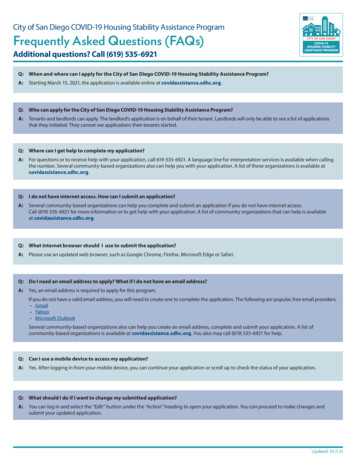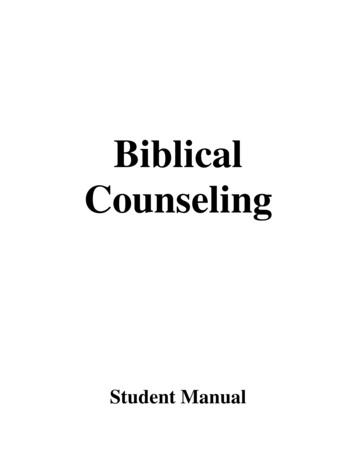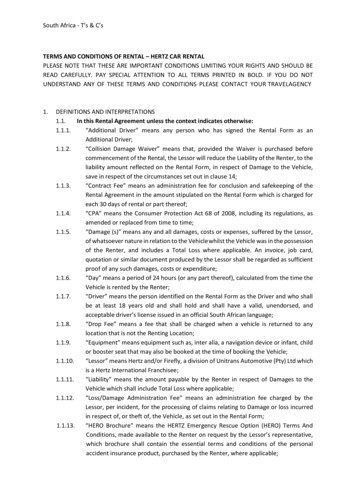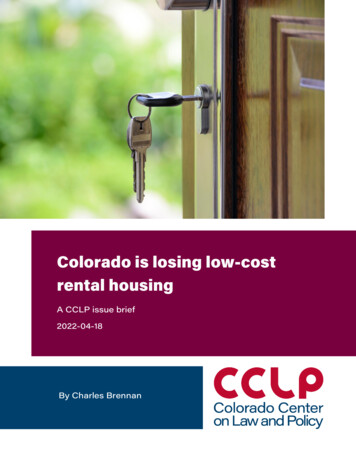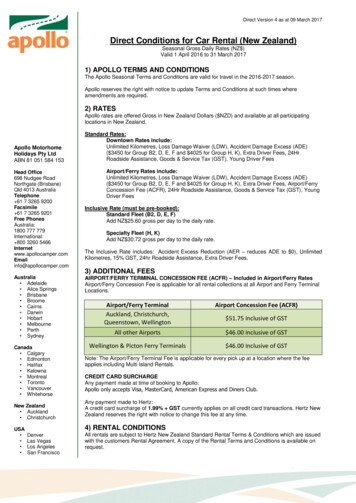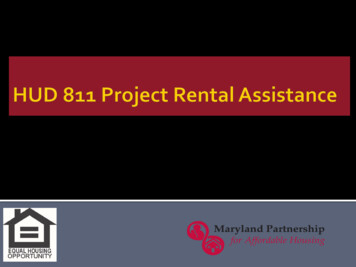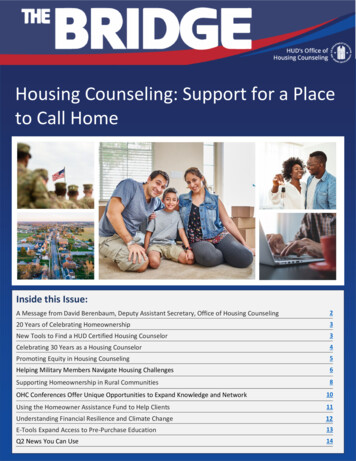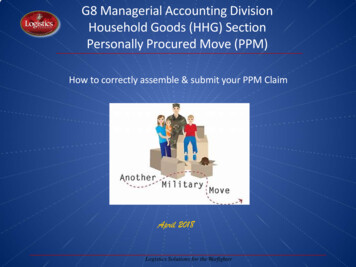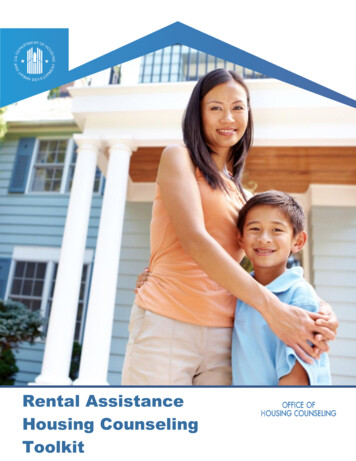
Transcription
Rental AssistanceHousing CounselingToolkit
TABLE OF CONTENTSSECTION 1PROVIDING RENTAL HOUSING COUNSELINGSECTION 2ASSISTANCE PROGRAMS FOR RENTERSSECTION 3RESOURCES FOR COUNSELING RENTERS34891314The information and guidance provided in this toolkit is intended to assist programparticipants with rental housing counseling. This toolkit does not supplant or supersedeOHC Housing Counseling Program (HCP) requirements including but not limited toSection 106 of the HUD Act of 1968, 24 CFR Part 214, 2 CFR Part 200, HCP NOFAs, HCPNotices, or NOFA Grant Agreements.HOUSING COUNSELING RENTAL HOUSING TOOLKIT November 20182
SECTION 1PROVIDING RENTAL HOUSINGCOUNSELINGHOUSING COUNSELING RENTAL HOUSING TOOLKIT November 20183
SECTION 1PROVIDING RENTAL HOUSING COUNSELINGRental housing is essential to many households. Housing counselors have an important role toplay in helping clients navigate the rental process and secure a unit that fits their budget.Housing counselors may help clients find rental assistance, understand Fair Housing laws,become familiar with tenant-landlord relationships and responsibilities of each, and provideappropriate information on general housing issues.What Housing Counselors Can Do for Renters Help clients identify an affordable unit. Counselors can work with their clients todevelop household budgets, determine what they can afford to pay for rent, establish ifthey are eligible for assistance, apply for rental assistance, and identify an appropriateunit.Teach renters their rights and responsibilities. Counselors can support their clients asthey navigate the rental process, from paying deposits to signing and ending a lease.They can teach them their rights and responsibilities as renters, help them build andkeep a good relationship and communication with their landlord, and help resolvelandlord-tenant disputes.Educate clients about financial planning and good rental practices. Counselors can helprenters develop and maintain financial literacy through counseling on budgeting, credit,and financial literacy for a future homeownership. They can also teach good rentalpractices such as obtaining rental insurance and maintaining a healthy home.Housing counseling is a continuum, and counselors may work with households to address theirunique housing goals. For instance, counselors may provide guidance to renters who ultimatelywish to become homebuyers. While this issue is not discussed in this toolkit, there are severallease-purchase programs available to qualified households that allow them to pay rent for theirunit and an additional amount that is accrued and may later be used as a down payment on thedwelling. Other programs offer the possibility of a household having a lease on a unit and aftera set time, the owner must offer the right of first refusal to that household. An example of thelatter form of lease-purchase program is through HUD’s HOME Investment PartnershipsProgram (HOME). Households wishing to enter lease-purchase arrangements face similar issuesto renter households, in that they often need assistance with credit issues, finding an affordableunit, and budgeting.Teaching About Tenant Rights and ResponsibilitiesHousing counselors can continue to provide significant support to renters once they haverented a unit. In some cases, affordable housing residents may need help understanding theirrights and responsibilities under the terms of a lease, or they may need counseling servicespertaining to landlord-tenant disputes. Federal and state laws protect tenants fromdiscrimination and define rights such as the right to a habitable home and the right to privacy inthe home. These laws also protect tenants from abuses such as withholding of security depositsand unlawful evictions. Tenants also have responsibilities under the terms of their leases.HOUSING COUNSELING RENTAL HOUSING TOOLKIT November 20184
SECTION 1Tenants’ responsibilities may include meeting security deposit obligations, providing thelandlord access to the premises, paying rent in a timely manner, and following paymentprocedures.When tenants and landlords are in conflict, housing counselors can help tenants by makingreferrals to legal aid organizations. If a tenant falls behind on rent, housing counselors may helpresidents to stay in their units by working with the resident and the landlord to develop arepayment plan and helping the resident to apply for funds to assist with unpaid and overduerents. Rental housing counseling can include working with residents’ landlords when problemsoccur. Such counseling might prevent evictions, as landlords may be willing to working withexisting residents to avoid paying for legal fees associated with evictions and unit turnovercosts associated with repairs and improvements.HUD provides information on its webpage about tenant rights and responsibilities and FairHousing requirements. See the checklist provided in Section 3 for a list of items to discuss withclients about their rights and responsibilities. See Section 4 of this guide for additionalresources related to tenant rights and responsibilities.Supporting Client Action Plans and Good Rental PracticesRelationships established through the rental counseling process puts the housing counselor inan excellent position to support renters in the pursuit of their larger financial goals and longterm healthy rental practices as provided in their client action plan. Counselors help clientsbuild and protect assets through counseling on credit, renters’ insurance, and emergencypreparedness. In addition, they can help their clients stay healthy through education on healthyhomes. See Section 3 for a list of items to discuss with clients about sound rental and financialpractices and Section 4 of this guide for additional counseling resources.Counseling Renters: A ChecklistThis checklist walks through the basic topics that a housing counselor can cover with a clientwho seeks or rents an affordable unit. Through this discussion, you can ensure that the clienthas a sustainable household budget, improves household financial capacity, has access to thehousing and non-housing resources they need, has solid knowledge of their Fair Housing andaccessibility rights, avoids eviction, and is prepared for safe and sustainable housing.Consider providing the renter with a copy of pages 7 and 8 of the How to be a Successful Renterguide developed by the Virginia Housing Development Agency or with HUD’s Renter’s Guidedeveloped by the Denver Field Office. Both provide 10 useful tips for renting a unit.Finding a Unit 1. Determine an affordable rent. Work with the client to confirm they are ready to rentand determine the portion of their household budget that should go toward housing: Determine if the client is eligible for rental assistance. Know the income thresholds by family size for your local area.HOUSING COUNSELING RENTAL HOUSING TOOLKIT November 20185
SECTION 12. Find an affordable unit. Help the client identify units in the area that fit their needsand budgets. Consider how many bedrooms they need and the type of housing that isbest for them (single family, single room occupancy, supportive housing): Develop a list of local subsidized units. Have contacts with local nonprofits, affordable housing agencies, and the publichousing authority (PHA). Develop contacts with landlords.3. Find rental assistance for market rate units. For clients with eligible incomes, helpthem apply for housing vouchers: Know the tenant-based rental assistance programs in your community. Help clients complete the application.4. Be alert for violations of fair housing laws. As a housing counselor, be aware ofpotential discrimination against your clients: Become familiar with Fair Housing laws. If you suspect that your client is the victim of discrimination, alert appropriateauthorities.5. Be alert for scams. Discuss common rental practices with your client so they do not fallprey to scams: If you hear of suspicious activity, such as requests for money before viewing theproperty, or requests for cash only, alert the authorities.Signing a Lease1. Understand the lease. Review the lease with the client and confirm they understandits provisions: Review basics such as the length of the lease, if it renews automatically, and if ithas month-to-month provisions. Make sure they know who manages the property and how to reach them. Discuss monthly financial obligations such as monthly rent and utilities, as well asthe security deposit, penalties for late payments, and any fees. Highlight the rights and responsibilities codified in the lease such as who isresponsible for repairs and when the landlord/property owner may enter the unit(see more on rights and responsibilities below under “Being a Renter”).2. Understand lead-based paint disclosure (if applicable). If the client is renting a homethat was constructed before 1978, make sure they are aware of their rights under theDisclosure Act. Use the Protect Your Family pamphlet to review the requirements.3. Pay deposits. Make sure the client understands the rules for security deposits: Review security deposit rules in your state. Know of local agencies that provide assistance with security deposits. Recommend that they document in writing and/or pictures any damage in the unitat the time they sign the lease, using a move-in/move-out inspection form, so thatthey are not held responsible for those items and can receive their full securitydeposit when they leave the unit.HOUSING COUNSELING RENTAL HOUSING TOOLKIT November 20186
SECTION 1Being a Renter1. Know your responsibilities as a tenant. Emphasize that compliance with leaseprovisions will help avoid landlord-tenant disputes and eviction proceedings and willensure repayment of the security deposit at the end of the lease.2. Know your rights as a tenant. Discuss tenant rights and what to do if they findthemselves in conflict with their landlord: Discuss tenant rights and protections. HUD provides a helpful list. Know your state and local laws on tenant rights. If the tenant is in subsidized housing, share this list of resident rights andresponsibilities. Address potential landlord-tenant disputes. Let the client know that the counselingagency can help them navigate disputes with their landlords.3. Obtain rental insurance. Discuss the types and benefits of renter’s insurance: Share information about where to obtain rental insurance. Provide basic information about the cost of rental insurance. Explain what is covered by rental insurance.4. Maintain your rental unit. Discuss tenant responsibilities for maintaining a safe unitand healthy unit: Discuss the tenant’s responsibility for keeping the unit clean and contacting thelandlord for repairs. Emphasize the landlord’s responsibility for providing a safe and habitable unit. Note that the landlord can hold the tenant financially responsible for repairs thatresulted from negligence on the tenant’s part. Discuss the benefits of maintaining a healthy unit. Use the Healthy Homes Toolkitand its checklists to review healthy homes issues for renters.Planning for a Stable Future1. Develop a long-term financial plan. Encourage your client to continue to work withthe housing counseling agency in one-on-one counseling or through group education: Encourage them to maintain a sustainable budget. Discuss a plan for improving their financial capacity. This could include counselingon budgeting, credit, insurance, plans to purchase a home, and other topics criticalto financial well-being.2. Access available resources. Help your client access other housing and non-housingresources that may be available to them, including but not limited to the Family SelfSufficiency Program.HOUSING COUNSELING RENTAL HOUSING TOOLKIT November 20187
SECTION 2ASSISTANCE PROGRAMS FORRENTERSHOUSING COUNSELING RENTAL HOUSING TOOLKIT November 20188
SECTION 2ASSISTANCE PROGRAMS FOR RENTERSLow- to moderate-income households have access to various resources to help address budgetshortfalls. This section focuses on rental assistance and the HUD Family Self-Sufficiency (FSS)Program. Housing counselors should also be familiar with the social services in their communitythat could help a client meet needs such as food, healthcare, and employment, as these impacta client’s ability to pay housing costs.Identifying Housing Needs and Finding an Affordable UnitCounselors routinely help clients develop realistic budgets, discuss ways to save money, andlearn about their housing needs to determine what they can afford to spend on housing. Lowincome households will often encounter a gap between what they can afford to pay for housingand the local housing market prices. In those cases, the counselor should help the client findrental assistance to fill that gap. This may mean helping the client identify a subsidized rentalunit (i.e., affordable housing unit), or it could mean helping the tenant obtain a housingvoucher that pays at least a portion of the difference between the market rent and what thetenant can afford to pay. For information on how much assistance a tenant may be eligible toreceive, refer to HUD’s Housing Choice Vouchers Fact Sheet.HUD provides two key resources for finding affordable rental housing and finding localassistance. Rental assistance programs are discussed in more detail later in this section, andadditional guidance on counseling renters about a suitable affordable unit is available in thecounseling checklist in Section 1.When working with senior citizens, counselors should note that many communities offer nonsubsidized housing for seniors 55 years or older. When living in non-subsidized rental housing,residents have more flexibility with the amount of assets they maintain, as their assets do notaffect their eligibility to live in the community. However, rents may increase over time, possiblyon an annual basis. Seniors must plan for potential increases when considering long-term nonsubsidized rental housing. Therefore, housing counselors may want to advise senior citizens ofaffordable rental housing that are subsidized, as described below.Rental AssistanceRental assistance is a form of subsidy that lowers the cost of rental housing for low-incomehouseholds. There are two types of rental assistance—tenant-based and project-based rentalassistance: Tenant-based rental assistance is tied to the tenant. It generally comes in the form avoucher, which the tenant can use to help pay the rent for an acceptable rental unit.Project-based rental assistance is tied to the unit. The unit receives a subsidy that allowsfor a lower rent amount. A qualified tenant can rent that unit at the subsidized rent.Both types of assistance require the administering agency to evaluate the household’scharacteristics to determine income eligibility. The administering agency reviews thehousehold’s characteristics, including family size, composition, and presence of an elderlyHOUSING COUNSELING RENTAL HOUSING TOOLKIT November 20189
SECTION 2and/or disabled family member. The administering agency also reviews the family’s income anddetermines whether the family is eligible to receive rental assistance. Usually, the family mustbe either low income (with a total household income of less than 50 percent of the medianincome for a family of that size in the geographic area in which the housing is located) or verylow income (with a total household income of less than 30 percent of the area median income).Tenant-Based Rental AssistanceTenant-based rental assistance is usually administered by a local government agency, such as aPHA. The agency determines if an applicant is eligible for assistance as well as the amount ofrent that the household can afford to pay toward rent and utilities, known as the tenantportion. The agency grants a voucher that the resident may use for any market rate unit. Thevoucher covers the difference between the tenant portion of the rent and the fair market rent1or a reasonable rent for the unit, plus an allowance for utilities.Key things to know about tenant-based rental assistance include the following: The most common type of tenant-based rental assistance is generally known as Section8 or Housing Choice Vouchers and is administered by a local housing authority.Because tenant-based rental assistance is tied to the tenant, it is portable. This meansthat if the tenant decides to move from an existing unit, the tenant may use the voucherfor any subsequent rental housing.The demand for tenant-based rental assistance typically exceeds the supply. Often,there are long waiting lists for these vouchers.To learn about tenant-based rental assistance available in their community, housing counselorscan contact the local housing authority or nonprofits involved in affordable housing. HUDprovides various types of rental assistance through PHAs, the HOME Program, and theContinuum of Care Program for homeless individuals and families. The Supportive Services forVeteran Families Program, a joint program administered by HUD and the U.S. Department ofVeterans Affairs, funds rapid re-housing and homelessness prevention for very low-incomeveterans. The following chart summarizes the most common forms of tenant-based rentalassistance and provides links to the agencies that administer them.Tenant-Based Rental Assistance Types and SourcesTo find out about:Housing Choice Vouchers (Section 8)Tenant-Based Rental Assistance (HOME Program)Tenant-Based Rental Assistance (homelessnessassistance programs)Tenant-Based Rental Assistance (HOPWA Program)Contact this agency in your community:Public Housing AuthoritiesHOME Program Participating JurisdictionHUD-funded Continuums of CareHousing Opportunities for Persons With AIDS(HOPWA) granteesFair market rent (FMR) is a term that HUD uses as gross rent estimates. They include the shelter rent plus the costof all utilities, except telephones. HUD sets FMRs to ensure that a sufficient supply of rental housing is available toprogram participants. The level at which FMRs are set is expressed as a percentile point within the rent distributionof standard-quality rental housing units. The current definition used is the 40th percentile rent, the dollar amountbelow which 40 percent of the standard-quality rental housing units are rented.1HOUSING COUNSELING RENTAL HOUSING TOOLKIT November 201810
SECTION 2Tenant-Based Rental Assistance Types and SourcesTo find out about:Multi-Family Housing Rental Assistance (rural)Supportive Services for Veteran Families (supportiveservices and rapid re-housing assistance)Contact this agency in your community:U.S. Department of Agriculture (USDA) RuralDevelopmentU.S. Department of Veterans AffairsProject-Based Rental Assistance (or Subsidized Units)Project-based rental assistance is administered by the owner or manager of the subsidizedrental property. The owner/manager will collect documentation on the applicant’s householdincome and characteristics. As with tenant-based rental assistance, they review the householdincome and size to determine eligibility and the tenant portion of the rent and utilities.Key things to know about project-based rental assistance include the following: If the resident moves out, then the assistance, or subsidy, stays with the unit.HUD, USDA, state, and local agencies have subsidized properties funded throughnumerous sources. Common ones include Low-Income Housing Tax Credit (LIHTC),Public Housing, and Project-Based Section 8 (see the table below for a more completelisting).Some properties are specifically designated for certain populations. For instance, HUDSection 202 properties are dedicated to elderly persons age 62 and over, while Section811 properties are dedicated to persons with disabilities.A property may be subsidized from multiple sources. For example, a property may havereceived tax credits and HOME funds.The demand for subsidized units is generally high and there is not necessarily acentralized waiting list for them. These properties have income restrictions that anyprospective resident must meet. For instance, to be eligible to reside in a Section 202property, the resident’s household income may not exceed 50% of the area medianincome for that family size, as defined by HUD.To learn more about project-based rental assistance available in the community, housingcounselors should connect with the local housing authority and nonprofits to get a list ofsubsidized units. The following chart indicates some of the common sources of project-basedrental assistance and links to the agencies that administer them.Project-Based Rental Assistance Types and SourcesTo find out about:HUD-insured or HUD-subsidized housing—Section 202, 811, 221(d)3, 236Project-Based Section 8Project-Based Rental AssistanceProject-Based Rental Assistance(homelessness assistance programs)Use these sources to find local programs and properties:HUD’s Office of Multifamily HousingHUD’s Office of Multifamily Housing Section 8 ExpiringContractsRental Assistance Demonstration Quick Reference Guideto Multifamily Housing RequirementsHUD-funded Continuums of CareHOUSING COUNSELING RENTAL HOUSING TOOLKIT November 201811
SECTION 2Project-Based Rental Assistance Types and SourcesTo find out about:Project-Based Rental Assistance (HOPWA)Rural affordable rental housing—Section515, Section 514/516, and Section 538Use these sources to find local programs and properties:HOPWA granteesU.S. Department of Agriculture (USDA) RuralDevelopment Multi-Family Housing RentalsIn addition, there may be other affordable rental housing projects available in your area thatinclude some form of public financing and may have affordable rents. These projects mightoffer project-based rental assistance. For more information on these programs, contact HOMEProgram Participating Jurisdictions, contact Community Development Block Grant grantees, orvisit HUD’s LIHTC rental housing project database.Family Self-Sufficiency ProgramThe FSS program is a HUD program that helps low-income families to increase their earnedincome and reduce their dependency on welfare assistance and rental subsidies throughplanning, training, and support. The FSS program is administered locally by PHAs. The PHAcollaborates with a Program Coordinating Committee (PCC) to secure commitments of publicand private resources for the operation of the FSS program. A PCC includes representativesfrom the PHA and public housing resident representatives and, in some cases, tenants receivingHousing Choice Vouchers. The PCC is made up of various organizations and its composition mayvary by PHA. Some of the most common PCC partners include Workforce Investment Boards,financial literacy and credit counseling providers, city or county government agencies, city orcounty human services/Temporary Assistance for Needy Families agencies, city or countydepartments of health and mental health, community colleges, and universities.Key things to know about the FSS program include the following: The FSS program is available to public housing residents, Housing Choice Voucherprogram participants, residents of assisted housing served by tribally designatedhousing entities, and residents of project-based rental assistance projects.To apply, a family should contact the PHA directly.An interest-bearing escrow account is established by the PHA for each participatingfamily. The PHA makes deposits to the account throughout the duration of the family’sparticipation in the FSS program if and when a family’s rent increases as a result of anincrease in their earned income.Housing counselors can help clients access the FSS program by contacting a PHA in their areathat administers an FSS program. Not all PHAs administer the FSS program. Contact your localPHA to find out if they have an FSS program.HOUSING COUNSELING RENTAL HOUSING TOOLKIT November 201812
SECTION 3RESOURCES FOR COUNSELINGRENTERSHOUSING COUNSELING RENTAL HOUSING TOOLKIT November 201813
SECTION 3RESOURCES FOR COUNSELING RENTERSTo find additional information for renters, consult the following resources.Resources for Counselors Providing Rental Housing CounselingFinding an Affordable Unit Finding federally subsidized units Using state and local program resources to locate affordable units Finding affordable housing and related resources near you Affordable units in properties supported by tax credits Finding subsidized units in rural areas State Housing Finance Agencies with affordable rental properties Housing Action Illinois Resources for Rental HousingTenant Rights and Responsibilities General information about tenant rights and responsibilities Rights and Responsibilities of residents of federally assisted housing Tenant rights by state Fair Housing State laws regarding security deposits How to Be a Successful Renter, from the Virginia Housing Development Authority Ten Tips for Tenants Resident’s Rights and ResponsibilitiesSupporting Good Rental Practices Credit, finance, and budgeting skills: Your Money, Your Goals Emergency Preparedness Toolkit Healthy Housing Toolkit Housing Counseling Capacity Building Toolkit HUD Handbook 4350.3: Occupancy Requirements of Subsidized Multifamily HousingPrograms, Rev-1, Appendix 5, Move-In/Move-Out Inspection FormAssistance Programs for RentersRental Assistance Resources Local rental assistance resources Housing Choice Vouchers Public housing Rental assistance in rural housing Rental assistance for veteran families Map-based search for affordable rental housing Local community development and affordable housing contactsFamily Self-Sufficiency Program FSS Fact Sheet Public Housing Agencies and Tribes that have received FSS Funding (2011–2015)HOUSING COUNSELING RENTAL HOUSING TOOLKIT November 201814
the housing counseling agency in one-on-one counseling or through group education: Encourage them to maintain a sustainable budget. Discuss a plan for improving their financial capacity. This could include counseling on budgeting, credit, insurance, plans to purchase a home, and other topics critical to financial well-being. 2.
